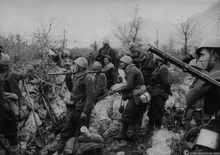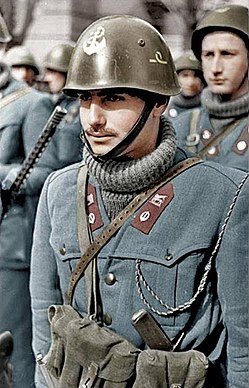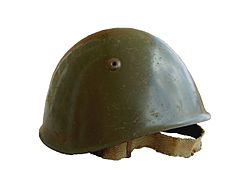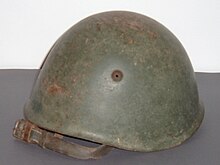|
M33 helmet
The M33 Helmet (Elmetto Modello 1933 in Italian) is a steel combat helmet designed in the 1930s in Italy, and was the standard combat helmet of the Regio Esercito up to World War II, and of the Esercito Italiano well into the Cold War. BackgroundDating back from 1925, the Italian Army had engaged in experiments to find a new model of combat helmet that could replace the aging and not completely satisfactory Adrian helmet adopted in 1915 upon the country's entry into World War I; coupled to this was that the Adrian was originally a French design, and it was probably felt (under the fascist regime) that an Italian-designed model was more appropriate. After lengthy trials (with prototypes from many Italian and foreign firms) in 1932, it was decided to adopt one of them as the M31 helmet. However this model (recognizable by the small crest on its top) was not completely satisfactory, because its cupolar blowhole design was not seen as being efficient, and was rather perceived as a structural weakness. By replacing it with three ventilation holes (two on the sides and one on the rear), the M33 and was fully adopted on November 29, 1934.[2] The M33 helmet would first enter use in the Second Italo-Ethiopian War in October 1935, followed by the Spanish Civil War in 1936, with Italy sending aid to the Nationalists under Francisco Franco as military aid. Upon the war's conclusion in 1939, departing Italian volunteers left approximately 50,000-60,000 M33 helmets behind, which saw use with the Spanish Army until the late 1970s when they were sold off following Franco's death.  In 1944–1945 following the Armistice of Cassibile, the British attempted to replace the M33 with the Brodie helmet, however only two divisions had switched by the time the war ended. Meanwhile, the Americans transferred their M1 helmets, but not enough to completely re-equip any large units. After the war, it was decided to retain the M33 in use with the newly formed Italian Army, remaining in use to the end of the 1980s, with production restarting in the 1950s. Said examples are nearly identical, but have a slightly different interior headband, a different serial number scheme, and a canvas chinstrap replacing the leather chinstrap.    Usage & usersWhile not possessing the same degree of protection offered by the German Stahlhelm, the M33 was seen as a successful design.
Notes
References
External linksWikimedia Commons has media related to Elmetto M33. |
||||||||||||||||||||||||||
